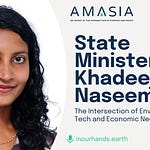In this episode of In Our Hands, Ramanan Raghavendran speaks with Latane Garetson, Director of Physical Infrastructure at Dropbox.
Garetson breaks down the physical infrastructure of data centers and their climate impact and then continues to discuss embracing efficiency technologies, setting targets to reduce environmental footprint, carbon offsetting, and why collaboration is key.
Full transcript available above. This episode is also available on Apple Podcasts and Spotify.
In Our Hands is a production of Amasia. Follow these links for more about our firm, the Amasia blog, our climate fiction podcast, and Ramanan’s blog.
Highlights
[02:32] The physical infrastructure of the cloud and its impact on climate
[04:32] Achieving 100% renewable energy for data centers
[07:09] The economic benefits of energy efficiency in data centers
[10:10] The challenges of getting renewable energy into multi-tenant buildings
[12:29] Dropbox's leadership in sustainability
[14:24] Is carbon offsetting the most impactful solution?
[15:52] Motivating other companies to take action by understanding their impact
[16:30] Investing in technologies for long-term benefits











